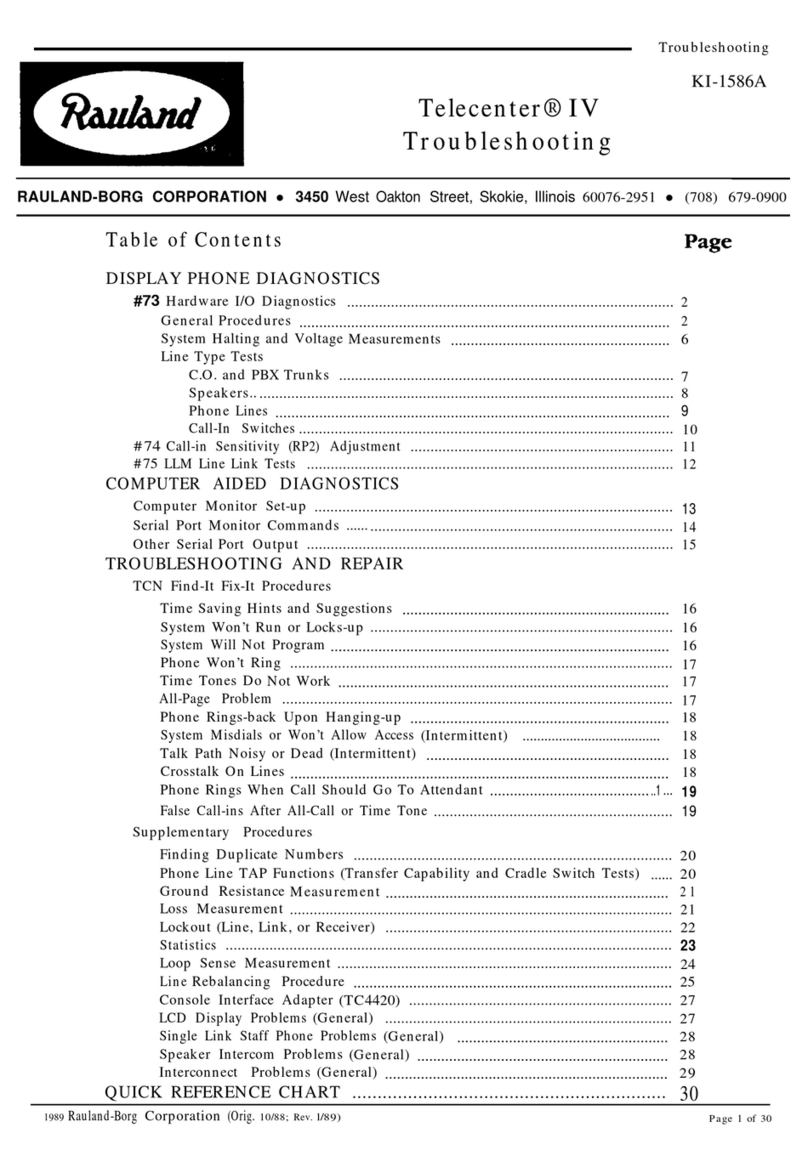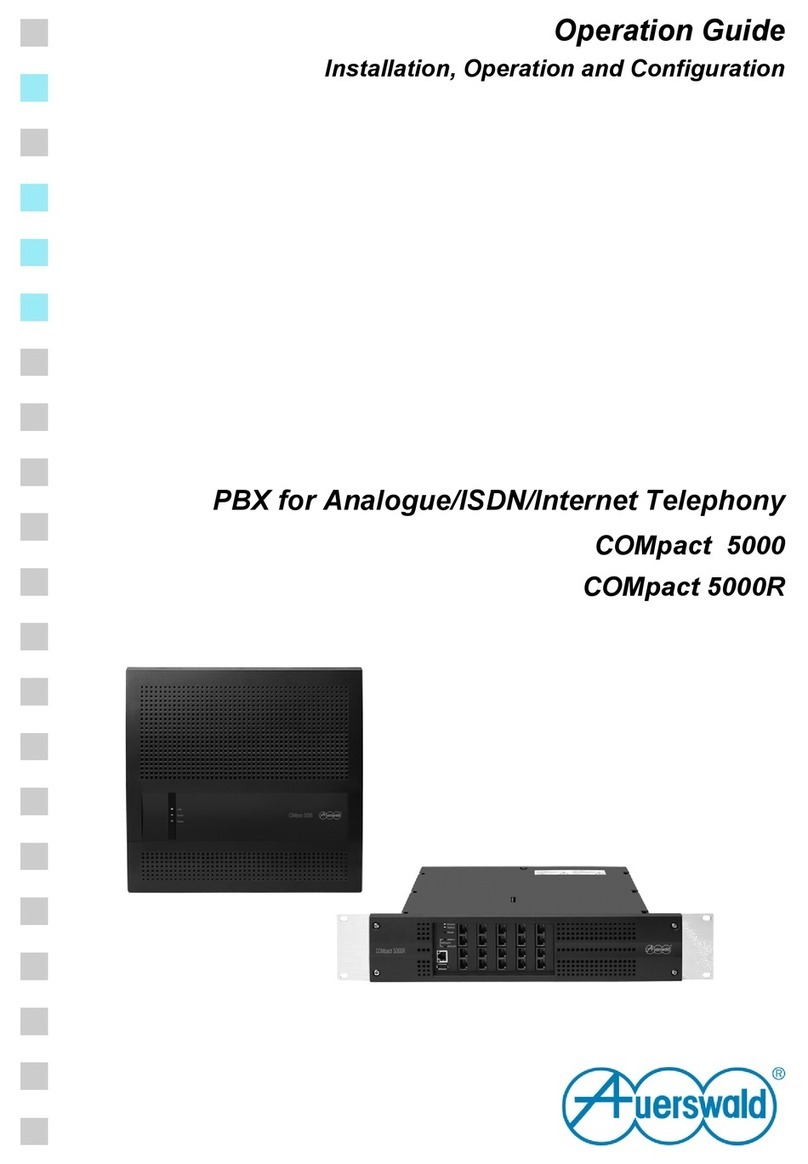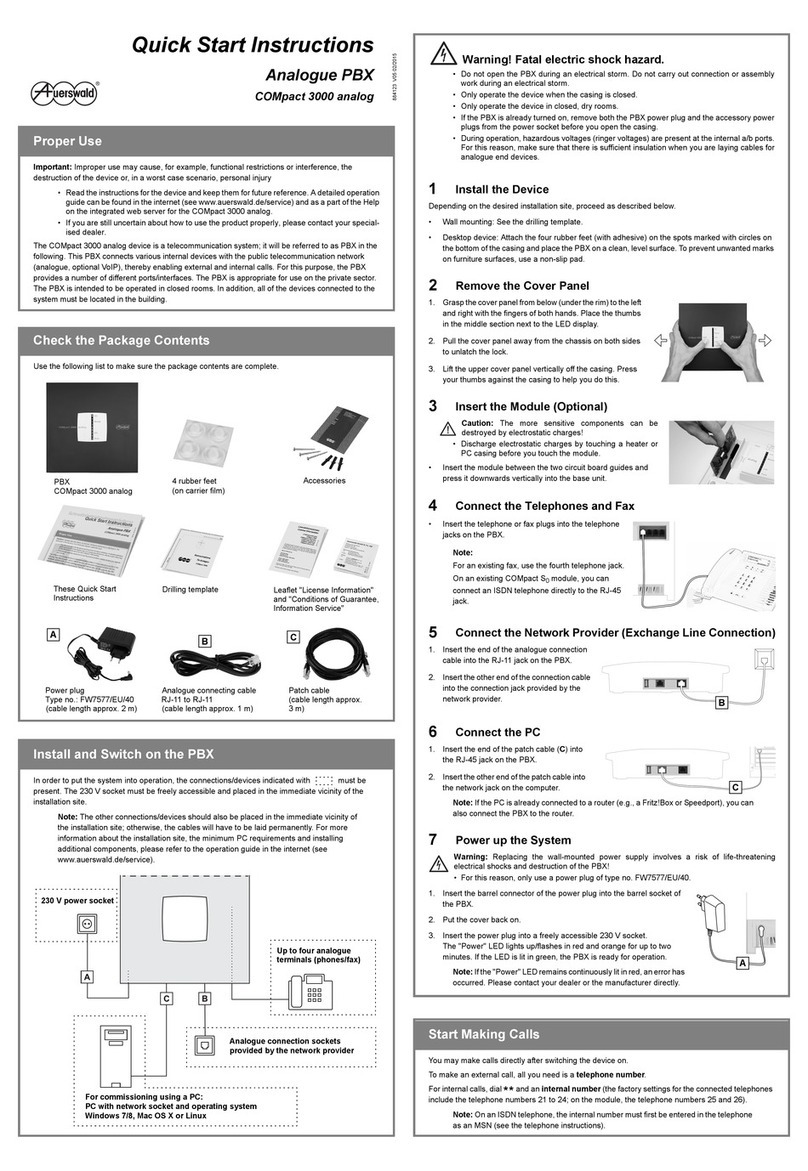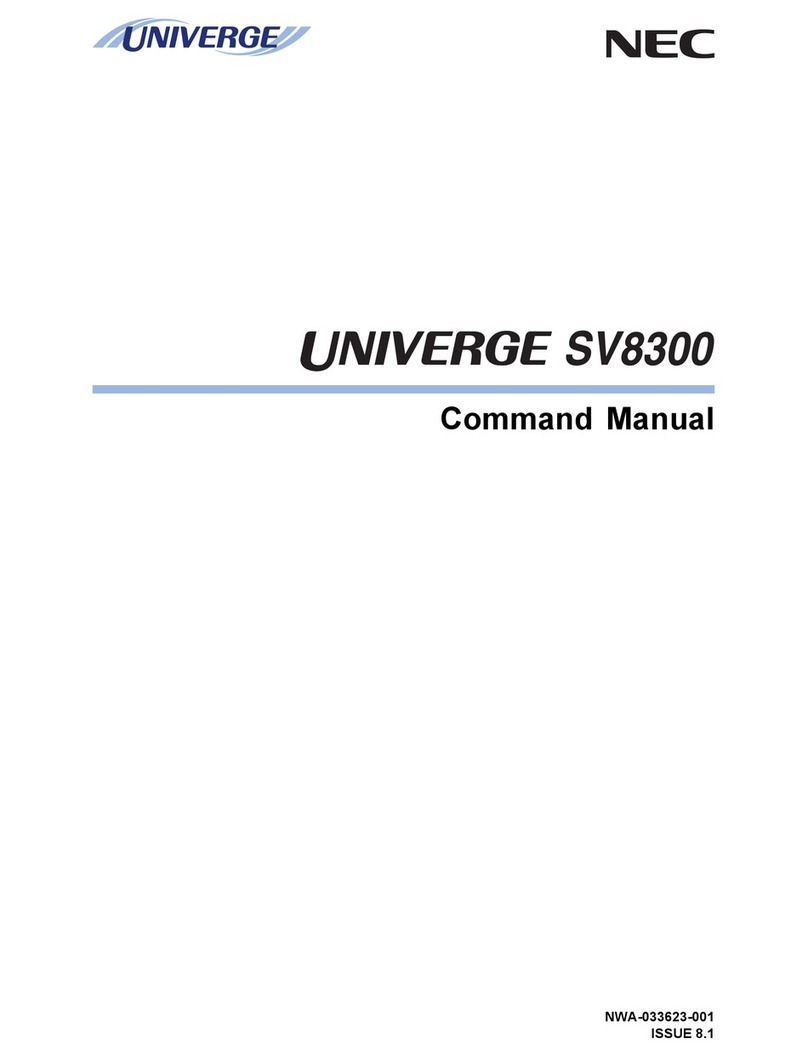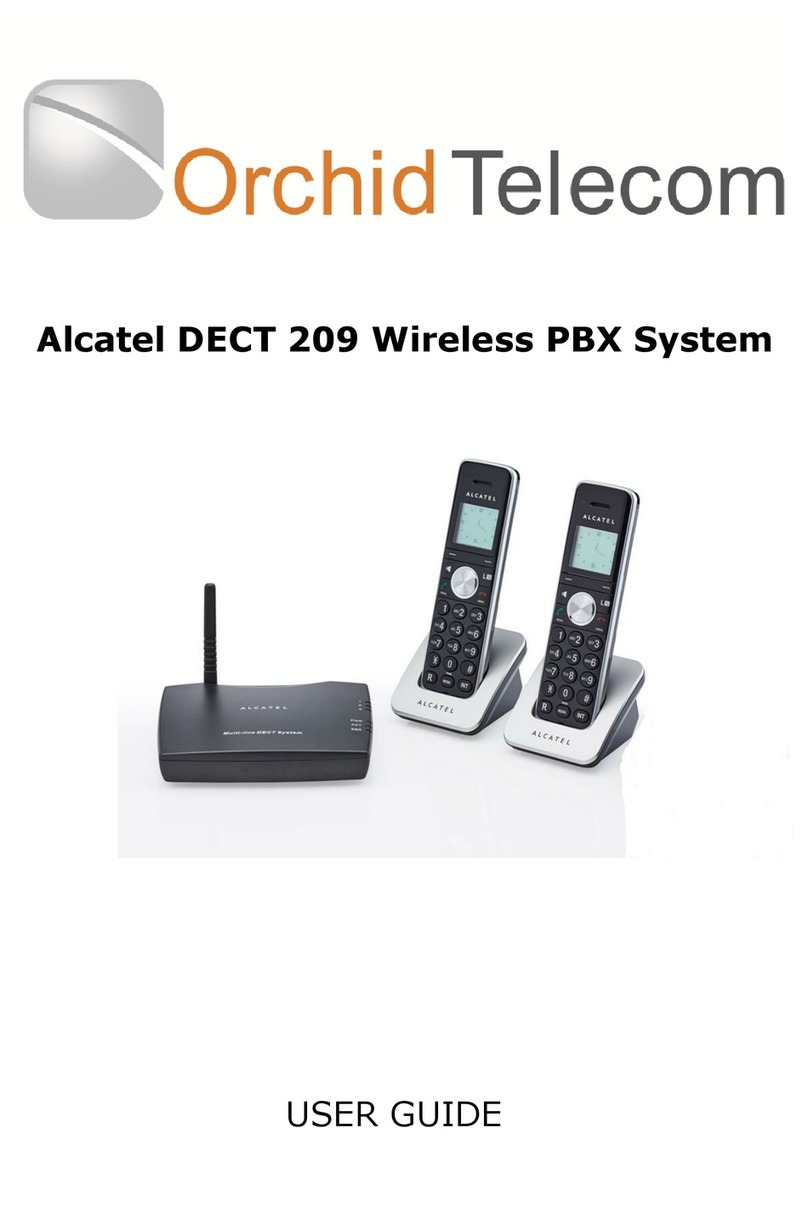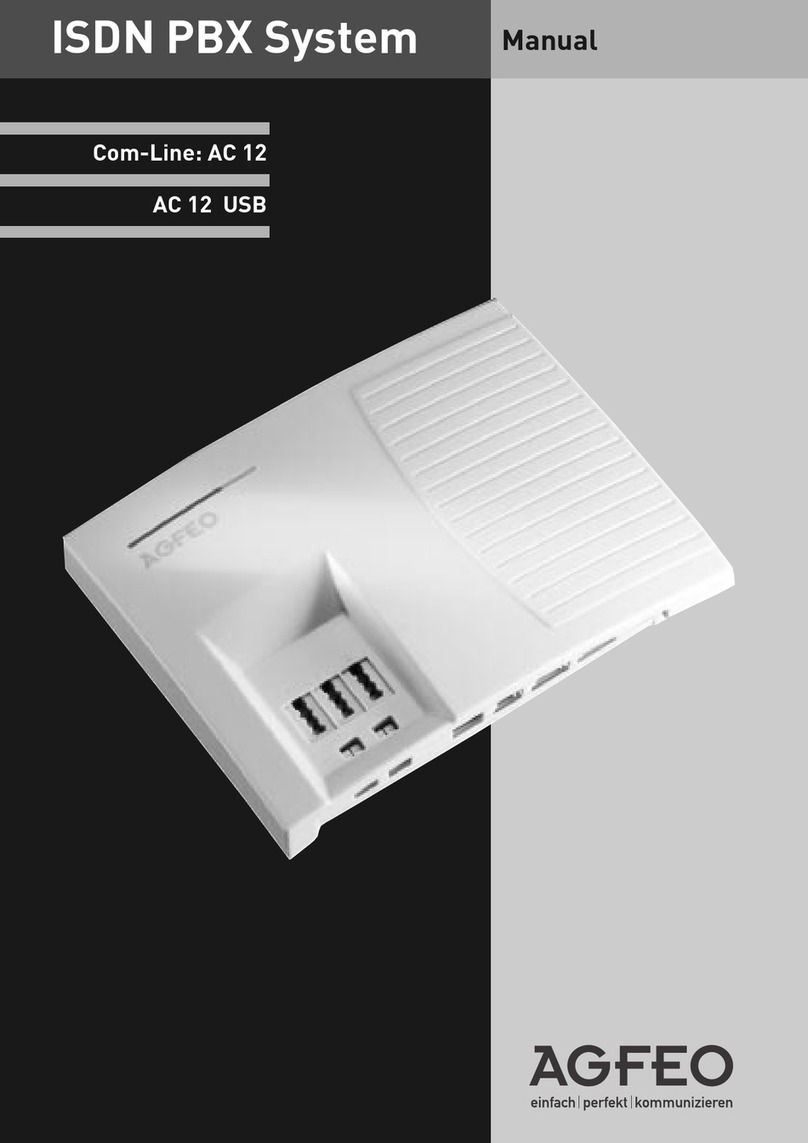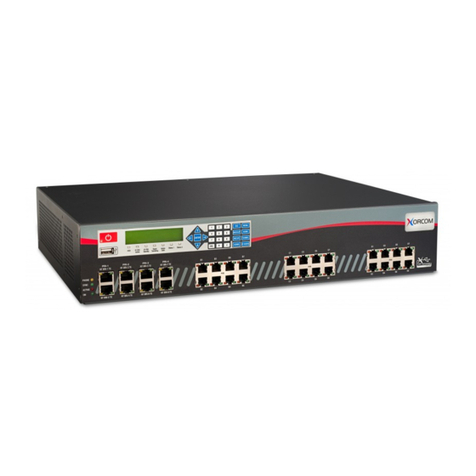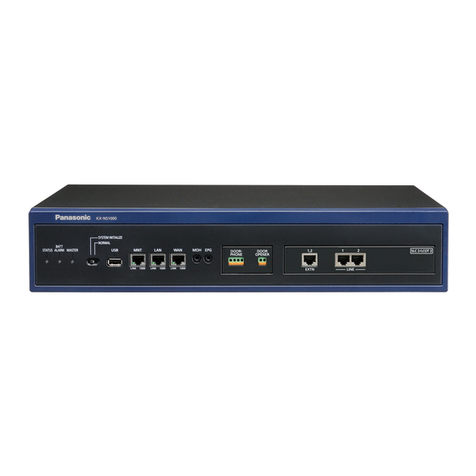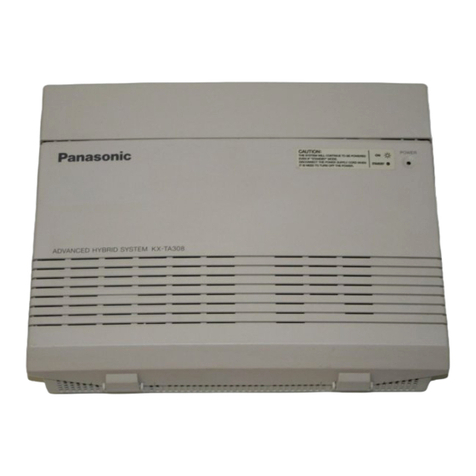Telesis PX24X User manual

PX24X
HYBRID IP PBX

IN BRIEF:
Thank you
... for purchasing the Telesis PX24X Hybrid IP PBX. It is manufactured to the highest
quality standards and tested vigorously to comply ith requirement for its product
specifications.
In this manual, you ill find basic information about the PX24X and quickly setting it
up. We hope that this simplified manual ill get you started and help you familiarize
ith your ne hybrid IP PBX system.
For the appropriate operation of your ne hybrid IP PBX, it may need programming
and/or licensing. Please contact your local Telesis Dealer for details.
We hope that your PX24X Hybrid IP PBX ill serve you ell and provide you ith all
your communication needs no and in the future.
Telesis CZ.
PX24X in Brief
Offering traditional and IP connections in one system, PX24X systems are suited for
SMEs and large enterprises ishing to migrate to IP PBX systems hile keeping
traditional TDM interfaces. There are analog subscribers and trunks, all featured ith
caller ID, as ell as 48 Vdc feed for analog subscribers to drive long loops. Solution
also offers 2- ire digital subscribers, Euro ISDN BRI (S0/T0, Uk0) ports, E1
interfaces ith numerous protocols, as ell as SIP and H.323 support/integration.
Integrated digital voice recorder has 100 hr capacity.
PX24X Package
Depending on your system specifications, components that come ith your order may
vary, please check your shipping list for a full description of hat as included in your
package.
Hardware: Modu arity
The Telesis PX24X Hybrid IP PBX has a control and s itching unit that stores the
necessary soft are to run the system. Interface cards are distributed inside the cabinets
and provide interfaces to other systems and users.
Hardware: Cabinets
Depending on configuration, the PX24X is made up of up to 4 cabinets that are
vertically stacked on top of each other. The lo est cabinet is different from the other
cabinets because it houses a different backplane to accommodate the control and
s itching unit. The lo est cabinet is called the main cabinet and the others are called
the auxiliary cabinets. Depending on your configuration a floor mounting part or a all
mounting part is supplied ith your system. Start your installation by stacking the
cabinets securely scre ing them together.
Hardware: Interface cards
Various interface cards are available for the PX24X to provide its user ith numerous
features. Interface cards are modular in nature as they can be installed in various slots
and any quantity up to the systems` maximum capacity.
Hardware: Digita phones
The PX24X may be ith optional digital phones. These may also be used as operators
consoles.
Software: Xymphony
Inside the control and s itching module there is a processor that controls all the tasks
related to the system such as s itching, signaling and voice messages. An operating
soft are (or firm are) called Xymphony runs inside this processor. The operating
soft are Xymphony comes installed at the factory but it can also be upgraded in the
field.
3

This page is left blank intentionally
HARDWARE:
Part Numbers (Ordering Codes)
Ordering Code Short Description
2.pxf.urnxmkn Main cabinet ith the backplane card.
2.pxf.urnxmk2 Auxiliary cabinet ith the backplane card.
1.pxf.duvmont Wall mounting part.
1.pxf.a tsehp Floor mounting part.
2.pxf.19inmkn 19inch rack mountable main cabinet ith
the backplane card.
2.pxf.19inmk2 19inch rack mountable auxiliary cabinet
ith the backplane card.
2.px0.psudurn Po er supply module for a cabinet.
2.px0.ipbxdf Control and s itching unit ith an
Ethernet interface + DVR (Digital Voice
Recorder)
1.px0.dffrak1 DFF card ith 1-cabinet-expanding
hard are.
1.px0.dffxrak DFF card ith expanding hard are up to
4-cabinet capacity.
1.px0.dffx1e1 DFF card ith expanding hard are up to
4-cabinet capacity, and one E1 interface.
4

1.px0.dffx2e1 DFF card ith expanding hard are up to
4-cabinet capacity, and t o E1 interfaces.
1.px0.dffx3e1 DFF card ith expanding hard are up to
4-cabinet capacity, and three E1
interfaces.
1.px0.dffx4e1 DFF card ith expanding hard are up to
3-cabinet capacity, and four E1 interfaces.
w.pxf. scxv52 License for a single V5.2 link.
w.pxf. scxss7 License for a single SS7 E1 interface.
w.pxf. scxdss License for a single ISDN E1 interface
(DSS1 and QSIG).
w.pxf. scxcas License for a single CAS E1 interface
(R1, R2, CIS, EM emulation..).
1.px0.dasf016 DASF analog subscriber (or FXS) line
card ith 16 subscriber circuits and Caller
ID insertion capability. Characteristic
impedance is 600 ohms.
1.px0.dasfc16 DASF analog subscriber (or FXS) line
card ith 16 subscriber circuits and Caller
ID insertion capability. Characteristic
impedance is complex.
2.dds.krtx001 DDS digital subscriber line card ith 15
4B+D ISDN digital subscriber circuits.
w.pxf. scx016 License for 1.px0.dasf016 or
1.px0.dasfc16 or 2.dds.krtx001.
1.pxf.datfr02 DATF analog DC loop trunk (i.e., CO
trunk or FXO) card ith 8 trunks and
Caller ID and 12kHz metering pulse
detection capability. Characteristic
impedance is 600 ohms.
1.pxf.datfr06 DATF analog DC loop trunk (i.e., CO
trunk or FXO) card ith 8 trunks and
Caller ID and 16kHz metering pulse
detection capability. Characteristic
impedance is 600 ohms.
1.pxf.datfc02 DATF analog DC loop trunk (i.e., CO
trunk or FXO) card ith 8 trunks and
Caller ID and 12kHz metering pulse
detection capability. Characteristic
impedance is complex.
1.pxf.datfc06 DATF analog DC loop trunk (i.e., CO
trunk or FXO) card ith 8 trunks and
Caller ID and 16kHz metering pulse
detection capability. Characteristic
impedance is complex.
w.pxf. scdatf License for 1.pxf.datfr02, 1pxf.datfr06,
1.pxf.datfc02 or 1.pxf.datfc06.
1.px0.demx004 DEM E&M signaling trunk card ith 4
interfaces.
5

w.pxf. scxem4 License for 1.px0.demx004.
1.px0.dd x004 DDL BRI-ISDN S0/T0 card ith 4
interfaces.
w.pxf. scxst4 License for 1.px0.ddlx004.
1.px0.ddux004 DDU BRI-ISDN Uk0 card ith 4
interfaces.
w.pxf. scxuk4 License for 1.px0.ddux004.
1.kb .f t4040 40-conductor 40cm flat cable.
1.kb .f t4085 40-conductor 85cm flat cable.
1.kb .f t4110 40-conductor 110cm flat cable.
2.dts.b821xxx Telesis DTS821 executive digital
telephone set ith large LCD and 62 keys.
2.dts.821ipph Telesis ITS821 VoIP telephone ith xSIP
(eXtended SIP) protocol.
w.pxf. ftx001 License for an ETSI-FSK transmitter.
w.pxf. frx001 License for an ETSI-FSK receiver.
w.pxf. scxses License for additional 8 channels for the
DVR.
w.pxf.voip002 License for 2 (TWO) VoIP channels for IP
to TDM and TDM to IP routing.
Whenever a channel is free, it can be used
by any TDM or VoIP user.
w.pxf. scxsip License for a single VoIP phone user ith
xSIP protocol (that is ITS821 or Xphone)
w.pxf. scencr AES-256 encryption license for VoIP
calls.
w.pxf.xmncmpn License for a single Xymphony-API
client.
w.pxf. scrcrd Auto voice recording channel license.
6

2.pxf.urnxmkn
Description
2.pxf.urnxmkn is the cabinet ith the backplane and side, front, top and bottom covers
for a PX24X Hybrid IP PBX. The control and s itching unit (2.px0.ipbxdfl) has to be
installed in this cabinet. The 2.pxf.urnxmkn has:
•One slot for the po er supply unit
•One slot for the control and s itching unit
•Six slots for the line cards
2.pxf.urnxmkn with its accompanying power supply unit 2.px0.psudurn (without front,
top and bottom covers).
2.pxf.urnxmkn with its front, top and bottom covers.
Number of units per system
One per each system.
Location
It is the lo est cabinet of a multiple cabinet PX24X.
7

2.pxf.urnxmk2
Description
2.pxf.urnxmk2s are the optional auxiliary cabinets (or expansion cabinets) ith the
backplane and side, front, top and bottom covers for the PX24X Hybrid IP PBX. Each
2.pxf.urnxmk2 has:
•One slot for the po er supply unit
•Eight slots for the line cards; DASF or DATF or DEM
2.pxf.urnxmk2 with its accompanying power supply unit 2.px0.psudurn (without front,
top and bottom covers).
2.pxf.urnxmk2 with its front, top and bottom covers.
Number of units per system
Up to three per each system.
Location
They are placed over the main cabinet of the PX24X.
8

1.pxf.duvmont
Description
1.pxf.duvmont is used for mounting a t o-cabinet PX24X Hybrid IP PBX system on
the all. Single cabinet PX24X systems do not require 1.pxf.duvmont for all
mounting. Three- and four-cabinet PX24X systems can not be all mounted.
Number of units per system
One per t o-cabinet PX24X.
Location
Bet een the all and the PX24X.
1.pxf.a tsehp
Description
1.pxf.altsehp is the floor mounting part , hich can be used ith single or multiple
cabinet PX24X Hybrid IP PBX systems ith 2.pxf.urnxmkn and 2.pxf.urnxmk2, hen
the system is fixed onto the floor.
Number of units per system
One.
Location
At the bottom of the PX24X.
2.pxf.19inmkn
Description
2.pxf.19inmkn is a 19 inch rack mountable cabinet ith the backplane and side, front,
top and bottom covers for a PX24X Hybrid IP PBX. The control and s itching unit
(2.px0.ipbxdfl) has to be installed in this cabinet. The 2.pxf.19inmkn has:
•One slot for the po er supply unit
•One slot for the control and s itching unit
•Six slots for the line cards
2.pxf. 9inmkn with its front, top and bottom covers.
9

Number of units per system
One per each system.
Location
Mounted to an industry standard 19 inch rack. It is the lo est cabinet of a multiple
cabinet PX24X.
2.pxf.19inmk2
Description
2.pxf.19inmk2s are the optional auxiliary cabinets (or expansion cabinets) ith the
backplane and side, front, top and bottom covers for the PX24X Hybrid IP PBX for 19
inch rack installations. Each 2.pxf.19inmk2 has:
•One slot for the po er supply unit
•Eight slots for the line cards
2.pxf. 9inmk2 with its front, top and bottom covers.
Number of units per system
Up to three per each system.
Location
They are mounted over the main cabinet of the PX24X in an industry standard 19 inch
rack.
2.px0.psudurn
Description
2.px0.psudurn is a s itching mode po er supply unit ith the conversion capability
of 230VAC to -48VDC and -48VDC to the other voltages and signals required by the
PX24X Hybrid IP PBX to operate. That makes the 2.px0.psudurn:
•System po er supply unit operating from the mains
•System po er supply unit operating from the -48VDC po er source
•Charger for back-up batteries
Input and output po er specifications for a 2.px0.psudurn are:
Input:
•180 - 260 VAC (0.4 Amp at 230VAC)
•45 - 54 VDC(1.3 Amp at 48VDC)
Output:
•+5VDC (3 Amp)
•-5VDC (0.3 Amp)
•-54VDC (1.1 Amp)
•+9 VDC (0.4 Amp)
•Ring (2 , 25Hz)
10

Number of units per system
One per each main and auxiliary cabinet
Location
Leftmost slot in a main or an auxiliary cabinet is reserved for a 2.px0.psudurn.
2.px0.psudurn in a main Cabinet
2.px0.psudurn in an auxiliary cabinet
This page is left blank intentionally
11

This page is left blank intentionally
1.px0.dffrak1
Description
The 1.px0.dffrak1 card provides circuits to drive a single auxiliary cabinet (expansion
cabinet). It used in t o-cabinet PX24X Hybrid IP PBX systems, hich do not require
E1 interfaces.
Number of units per system
There can be only one DFF card in any type per system.
Location
Main cabinet (2.pxf.urnxmkn or 2.pxf19inmkn), the first slot to the right of the po er
supply unit. Mounted over the control and s itching unit (2.px0.ipbxdfl).
12

1.px0.dffxrak
Description
The 1.px0.dffxrak card provides circuits to drive three auxiliary cabinets (expansion
cabinets). It used in three- and four-cabinet PX24X Hybrid IP PBX systems, hich do
not require E1 interfaces.
Number of units per system
There can be only one DFF card in any type per system.
Location
Main cabinet (2.pxf.urnxmkn or 2.pxf19inmkn), the first slot to the right of the po er
supply unit. Mounted over the control and s itching unit (2.px0.ipbxdfl).
1.px0.dffx1e1
Description
1.px0.dffx1e1 is a 2.048 Mbit E1 (ITU-T G.703) digital interface card providing one
E1.The E1 can connect to 120 ohm balanced (or optional 75 ohm unbalanced)
terminations. The clock of the PX24X Hybrid IP PBX system can be programmed to
synchronize ith the E1 or it may run freely. The line code is programmable as AMI
or HDB3. Cyclic redundancy check (CRC4) can be enabled or disabled for the E1
interface. The direction of each channel of the E1 can be programmed as incoming,
outgoing, both- ay, or unavailable and therefore yields fractional E1 connection. The
types of signaling / protocol available for the E1 interface are:
•Channel-Associated Signaling (CAS)
•Single-bit E&M emulation
•T o-bit ITU-T R1
•T o-bit ITU-T R2
•Many variations of signaling types (such as CL-1B, OCL-1B, TCL-
1B, SL/ZSL, SLM) idely employed in CIS countries
•Common-Channel Signaling (CCS)
•DSS1 (Euro-ISDN in the TE direction)
•DSS1 (Euro-ISDN in the NT direction)
•ECMA QSIG (in the TE direction)
•ECMA QSIG (in the NT direction)
•ITU-T Signaling System No.7 ISUP
•V5.2 LE and AN protocol
In addition to the E1 interface, the card provides circuits to drive up to three auxiliary
cabinets in a system.
License
Depending on the signaling / protocol type for the E1 interface, one of the follo ing
licenses is required.
•.pxf.lscxv52
13

•.pxf.lscxss7
•.pxf.lscxdss
•.pxf.lscxcas
Number of units per system
There can be only one DFF card in any type per system.
Location
Main cabinet (2.pxf.urnxmkn or 2.pxf19inmkn), the first slot to the right of the po er
supply unit. Mounted over the control and s itching unit (2.px0.ipbxdfl).
1.px0.dffx2e1
Description
1.px0.dffx2e1 is a 2.048 Mbit E1 (ITU-T G.703) digital interface card providing t o
E1s. The E1s can connect to 120 ohm balanced (or optional 75 ohm unbalanced)
terminations. The clock of the PX24X Hybrid IP PBX can be programmed to
synchronize ith any of the t o E1s or it may run freely. The line code is
programmable as AMI or HDB3. Cyclic redundancy check (CRC4) can be enabled or
disabled for each E1 interface individually. The direction of each channel of each E1
can be programmed as incoming, outgoing, both- ay, or unavailable and therefore
yields fractional E1 connections. The types of signaling / protocol available for the E1
interfaces are:
•Channel-Associated Signaling (CAS)
•Single-bit E&M emulation
•T o-bit ITU-T R1
•T o-bit ITU-T R2
•Many variations of signaling types (such as CL-1B, OCL-1B, TCL-
1B, SL/ZSL, SLM) idely employed in CIS countries
•Common-Channel Signaling (CCS)
•DSS1 (Euro-ISDN in the TE direction)
•DSS1 (Euro-ISDN in the NT direction)
•ECMA QSIG (in the TE direction)
•ECMA QSIG (in the NT direction)
•ITU-T Signaling System No.7 ISUP
•V5.2 LE and AN protocol
In addition to E1 interfaces, the card provides circuits to drive up to three auxiliary
cabinets in a system.
License
Each E1 interface requires one of the follo ing licenses for the signaling / protocol
support.
14

•.pxf.lscxv52
•.pxf.lscxss7
•.pxf.lscxdss
•.pxf.lscxcas
Number of units per system
There can be only one DFF card in any type per system.
Location
Main cabinet (2.pxf.urnxmkn or 2.pxf19inmkn), the first slot to the right of the po er
supply unit. Mounted over the control and s itching unit (2.px0.ipbxdfl).
1.px0.dffx3e1
Description
1.px0.dffx3e1 is a 2.048 Mbit E1 (ITU-T G.703) digital interface card providing three
E1s. The E1s can connect to 120 ohm balanced (or optional 75 ohm unbalanced)
terminations. The clock of the PX24X Hybrid IP PBX can be programmed to
synchronize ith any of the E1s or it may run freely. The line code is programmable
as AMI or HDB3. Cyclic redundancy check (CRC4) can be enabled or disabled
for each E1 interface individually. The direction of each channel of each E1 can be
programmed as incoming, outgoing, both- ay, or unavailable and therefore yields
fractional E1 connections. The types of signaling / protocol available for the E1
interfaces are:
•Channel-Associated Signaling (CAS)
•Single-bit E&M emulation
•T o-bit ITU-T R1
•T o-bit ITU-T R2
•Many variations of signaling types (such as CL-1B, OCL-1B, TCL-
1B, SL/ZSL, SLM) idely employed in CIS countries
•Common-Channel Signaling (CCS)
•DSS1 (Euro-ISDN in the TE direction)
•DSS1 (Euro-ISDN in the NT direction)
•ECMA QSIG (in the TE direction)
•ECMA QSIG (in the NT direction)
•ITU-T Signaling System No.7 ISUP
•V5.2 LE and AN protocol
In addition to E1 interfaces, the card provides circuits to drive up to three auxiliary
cabinets in a system.
License
Each E1 interface requires one of the follo ing licenses for the signaling / protocol
support.
15

•.pxf.lscxv52
•.pxf.lscxss7
•.pxf.lscxdss
•.pxf.lscxcas
Number of units per system
There can be only one DFF card in any type per system.
Location
Main cabinet (2.pxf.urnxmkn or 2.pxf19inmkn), the first slot to the right of the po er
supply unit. Mounted over the control and s itching unit (2.px0.ipbxdfl).
1.px0.dffx4e1
Description
1.px0.dffx4e1 is a 2.048 Mbit E1 (ITU-T G.703) digital interface card providing four
E1s. The E1s can connect to 120 ohm balanced (or optional 75 ohm unbalanced)
terminations. The clock of the PX24X Hybrid IP PBX can be programmed to
synchronize ith any of the E1s or it may run freely. The line code is programmable
as AMI or HDB3. Cyclic redundancy check (CRC4) can be enabled or disabled
for each E1 interface individually. The direction of each channel of each E1 can be
programmed as incoming, outgoing, both- ay, or unavailable and therefore yields
fractional E1 connections. The types of signaling / protocol available for the E1
interfaces are:
•Channel-Associated Signaling (CAS)
•Single-bit E&M emulation
•T o-bit ITU-T R1
•T o-bit ITU-T R2
•Many variations of signaling types (such as CL-1B, OCL-1B, TCL-
1B, SL/ZSL, SLM) idely employed in CIS countries
•Common-Channel Signaling (CCS)
•DSS1 (Euro-ISDN in the TE direction)
•DSS1 (Euro-ISDN in the NT direction)
•ECMA QSIG (in the TE direction)
•ECMA QSIG (in the NT direction)
•ITU-T Signaling System No.7 ISUP
•V5.2 LE and AN protocol
In addition to E1 interfaces, the card provides circuits to drive up to three auxiliary
cabinets in a system.
License
Each E1 interface requires one of the follo ing licenses for the signaling / protocol
support.
16

•.pxf.lscxv52
•.pxf.lscxss7
•.pxf.lscxdss
•.pxf.lscxcas
Number of units per system
There can be only one DFF card in any type per system.
Location
Main cabinet (2.pxf.urnxmkn or 2.pxf19inmkn), the first slot to the right of the po er
supply unit. Mounted over the control and s itching unit (2.px0.ipbxdfl).
w.pxf. scxv52
Description
In a PX24X Hybrid IP PBX, each E1 link in a V5.2 interface requires a .pxf.lscxv52
license. The license is granted to a particular PX24X system and it is non-transferable.
w.pxf. scxss7
Description
In a PX24X Hybrid IP PBX, each SS7/E1 interface – that is an E1 ith a Signaling
System No.7 signaling path or sharing a common signaling path on any other E1-
requires a .pxf.lscxss7 license. The license is granted to a particular PX24X system
and it is non-transferable.
w.pxf. scxdss
Description
In a PX24X Hybrid IP PBX, each E1 interface ith the follo ing Primary Rate ISDN
signaling types requires a .pxf.lscxdss license.
•DSS1 Euro-ISDN TE (terminal side)
•DSS1 Euro-ISDN NT (net ork side)
•ECMA QSIG TE (terminal side)
•ECMA QSIG NT (net ork side)
The license is granted to a particular PX24X system and it is non-transferable.
w.pxf. scxcas
Description
In a PX24X Hybrid IP PBX, each E1 interface ith the follo ing Channel Associated
Signaling (CAS) types requires a .pxf.lscxcas license.
•Single-bit E&M emulation
17

•T o-bit ITU-T R1
•T o-bit ITU-T R2
•ANI (Automatic Number Identification) detection and query idely
employed in CIS countries
•Variations of CIS signaling types (such as CL-1B, OCL-1B, TCL-1B,
SL/ZSL, SLM) idely employed in CIS countries
The license is granted to a particular PX24X system and it is non-transferable.
1.px0.dasf016
Description
The PX24X Hybrid IP PBX` analog subscriber line card (or FXS card) 1.px0.dasf016
has 16 subscriber-loop interface circuits. The subscriber interface can drive loops up
to 3,000 ohm resistance (including the terminal equipment) and is capable of on-hook
transmission such as sending Caller ID information. The subscriber line card is for
600ohm resistive input impedance. The subscriber circuits have over-voltage
protection, conforming to ITU-T K.20/K.21 recommendations.
License
Each 1.px0.dasf016 card requires a .pxf.lscx16 license to operate in a PX24X system.
Number of units per system
Up to 28 units of DASF card in any type (1.px0.dasf016 or 1.px0.dasfc16).
Slots, which can house .px0.dasf0 6 cards in the main cabinet 2.pxf.urnxmkn or
2.pxf. 9inmkn.
Slots, which can house .px0.dasf0 6 cards in the first auxiliary cabinet 2.pxf.urnxmk2
or 2.pxf. 9inmk2.
18

Slots, which can house .px0.dasf0 6 cards in the second and third auxiliary cabinets
2.pxf.urnxmk2 or 2.pxf. 9inmk2.
1.px0.dasfc16
Description
The PX24X Hybrid IP PBX` analog subscriber line card (or FXS card) 1.px0.dasfc16
has 16 subscriber-loop interface circuits. The subscriber interface can drive loops up
to 3,000 ohm resistance (including the terminal equipment) and is capable of on-hook
transmission such as sending Caller ID information. The subscriber line card is for
complex input impedance. The subscriber circuits have over-voltage protection,
conforming to ITU-T K.20/K.21 recommendations.
License
Each 1.px0.dasfc16 card requires a .pxf.lscx16 license to operate in a PX24X system.
Number of units per system
Up to 28 units of DASF card in any type (1.px0.dasf016 or 1.px0.dasfc16).
Slots, which can house .px0.dasfc 6 cards in the main cabinet 2.pxf.urnxmkn or
2.pxf. 9inmkn.
Slots, which can house .px0.dasfc 6 cards in the first auxiliary cabinet 2.pxf.urnxmk2
or 2.pxf. 9inmk2.
19

Slots, which can house .px0.dasf0 6 cards in the second and third auxiliary cabinets
2.pxf.urnxmk2 or 2.pxf. 9inmk2.
2.dds.krtx001
Description
The PX24X Hybrid IP PBX` digital subscriber line card 2.dds.krtx001 has 15 (fifteen)
4B+D ISDN digital subscriber circuits. An appropriate Telesis digital set may connect
to the 2.dds.krtx001 over t o ires (a single pair of ires).
License
Each 2.dds.krtx001 card requires a .pxf.lscx16 license to operate in a PX24X system.
In other ords, .pxf.lscx16 license is for both analog and digital subscribers.
Number of units per system
Up to 4 units of DDS card.
Slots, which can house 2.dds.krtx001 cards in the main cabinet 2.pxf.urnxmkn or
2.pxf. 9inmkn.
w.pxf. scx016
Description
Each 1.px0.dasf016 or 1.px0.dasfc16 or 2.dds.krtx001 card requires a .pxf.lscx016
license to operate in a PX24X Hybrid IP PBX system. The license is granted to a
particular PX24X system and it is non-transferable.
1.pxf.datfr02
Description
The PX24X Hybrid IP PBX` analog DC loop trunk card (or FXO card) 1.pxf.datfr02
has eight line circuits that can detect line DC feed, polarity reversal, and 12 kHz
charge pulses and are capable of on-hook reception of tones such as receiving Caller
ID information transmitted. The analog DC loop trunk card is for 600 ohm resistive
reference impedance. Over-voltage and over-current protection on analog trunks
conforms to ITU-T K.20/K.21 recommendations.
20
Table of contents
Popular PBX manuals by other brands

Nortel
Nortel Meridian Meridian 1 manual
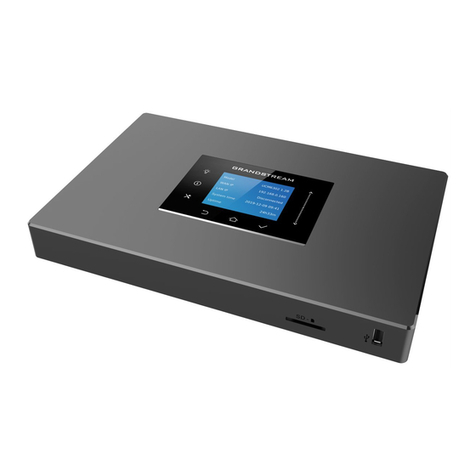
Grandstream Networks
Grandstream Networks UCM6301 Quick installation guide

Candour Communications
Candour Communications 308 quick start guide
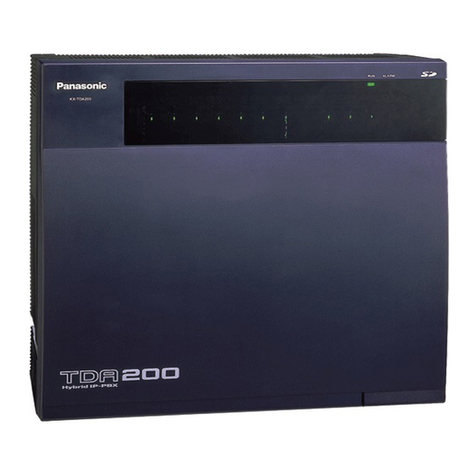
Panasonic
Panasonic HYBRID IP-PBX KX-TDA100 Programming manual
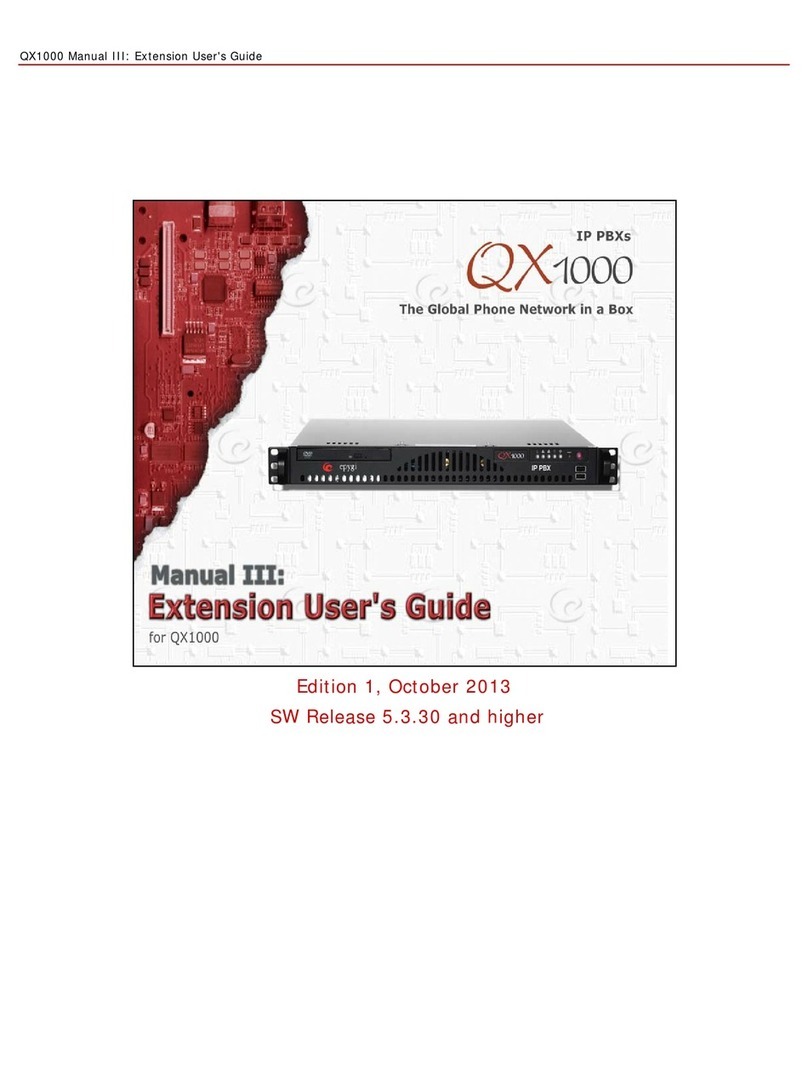
EPIGY
EPIGY QX1000 Extension user guide
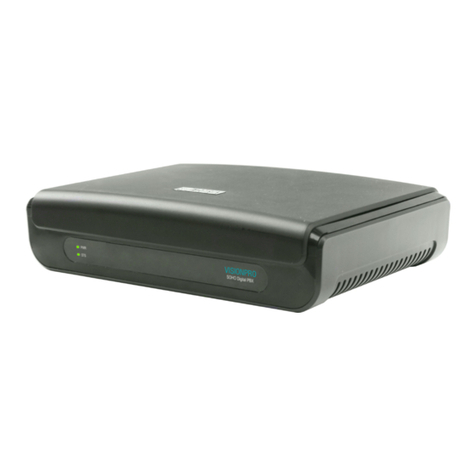
Matrix
Matrix Visionpro quick start

